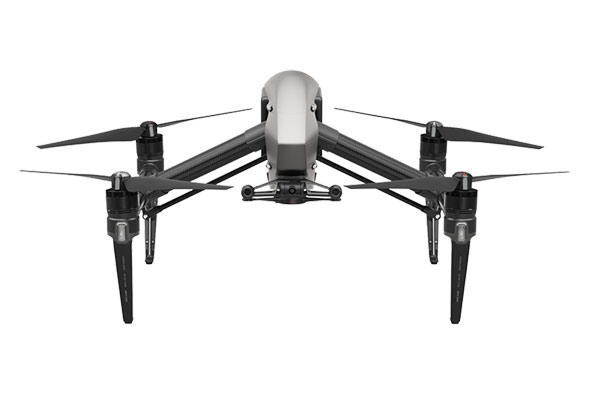Three New Pro-Level Drones to Ship By Year's End
Even as it works out supply problems with its consumer-level Mavic Pro, DJI has turned its attention back to pro (and prosumer) markets with the introduction of three new drones — the Matrice 600 Pro, the Inspire 2, and the Phantom 4 Pro.
Matrice 600 Pro
The Matrice 600 (M600) Pro (pictured, top of page) carries a maximum camera payload of 6 kg, enough to carry popular micro-four-thirds (MFT) cameras as well as the Red Epic. The Pro version of the M600 builds on its predecessor with new 2170R propeller for improved efficiency and stability and DJI's A3 Pro flight control system, with algorithms to compare data from three sets of navigation satellite receivers and vibration damping balls that absorb shake and reduce noise.
DJI says the M600 Pro is accurate to the centimeter. What's more, when the M600 Pro is folded up, it's actually smaller in size than the M600.
The M600 Pro can hit a maximum speed of 40 mph and reach 8,202 feet above sea level. Supported DJI gimbals include the Ronin-MX; the Zenmuse Z30, Zenmuse X5/X5R, Zenmuse X3, and Zenmuse XT; the Zenmuse Z15 Series HD Gimbal: and the Z15-A7, Z15-BMPCC, Z15-5D III, and Z15-GH4.
At DJI's website, the M600 Pro is $4,999 with an estimated shipping date of 15-20 business days from payment.
Inspire 2

Next up is the Inspire 2, with a top speed of 67 mph, a zero-to-50mph acceleration time of four seconds, a climbing speed of close to 20 feet/second, a descent speed of close to 30 feet/second, and a service ceiling of 16,404 feet above sea level (with optional high-altitude propellers).
The Inspire 2 has a built-in first-person camera facing forward, while a Zenmuse camera mounted on the main gimbal delivers a higher-quality feed. In fact, quality is the keyword here, as DJI introduces the CineCore 2.0 image-processing system, which allows 5.2K resolution video to be captured in the Adobe CinemaDNG raw format and recorded to SSD storage at 4.2 Gbps. Other supported formats include Apple ProRes 422 HQ (at 5.2K and 4K), ProRes 4444 XQ (at 4K only), and H.264/H.265 at up to 100 Mbps in 4K mode. Video streams from the Inspire 2 at 1080/50i or 720/60p.
Current Zenmuse camera options for the Inspire 2 are the X4S or X5S. The X4S has a one-inch 20 megapixel sensor with 11.6 stops of dynamic range and a fixed lens with a wide-angle lens (DJI reports a 35mm-equivalent focal length of 24mm). The X4S offers aperture control from f2.8 to f11 and a mechanical shutter that the company said cancels rolling-shutter effects. The X5S has an MFT sensor with 20.8 megapipxels and 12.8 stops of dynamic range, DJI said. It can use eight different lenses, including wide angles and zooms, and can shoot still images in burst mode at 20fps. (DJI said it plans to offer a handheld mount for both cameras in the future.)
The Inspire 2 sells for $2,999 as an aircraft only with no Zenmuse camera. A combo package is $6,198 ($5,999 through the end of the year)and includes the drone, a Zenmuse X5S, and a license key for CinemaDNG and Apple ProRes. The combo package is set to ship early next month, with standalone drone orders to follow in early January, DJI said.
Phantom 4 Pro

Finally, DJI offered the Phantom 4 Pro, a new upgrade to its popular Phantom 4. The Phantom 4 Pro sports a new camera with a 24mm (35mm equivalent) focal length, a one-inch 20 megapixel CMOS sensor with a mechanical shutter, and the ability to capture slow-motion 4K 60fps video at a bitrate of up to 100 Mbps with H.264 and H.265 compression. The Phantom 4 Pro has a maximum 30 minute flight time, and flies at a top speed of 45 mph in sport mode.
The Phantom 4 Pro sells for $1,499 with a standard controller, or for $1,799 with a contoller that features a high-luminance 5.5-inch display for better visibility during flight. Shipments are expected to begin in one week.
DJI: www.dji.com
Sections: Technology
Topics: dji drones inspire 2 matrice 600 pro phantom 4 pro
Did you enjoy this article? Sign up to receive the StudioDaily Fix eletter containing the latest stories, including news, videos, interviews, reviews and more.
